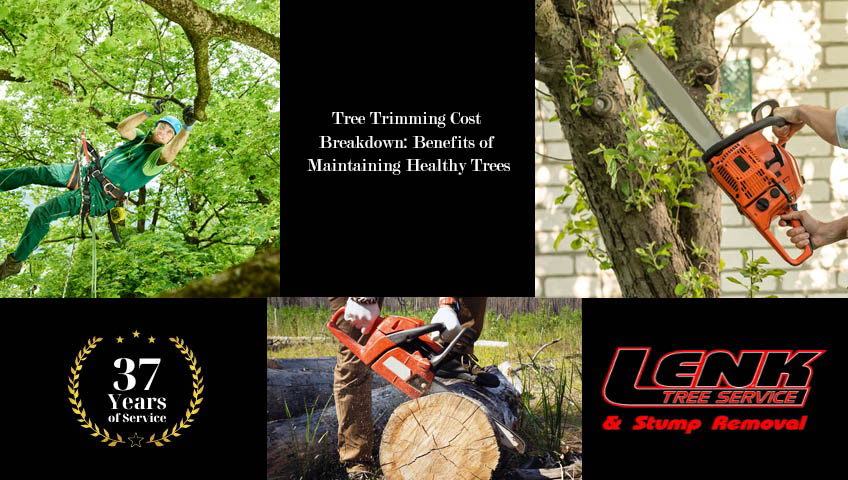Tree trimming, also known as tree pruning, is an essential aspect of proper tree care and maintenance. It involves the selective removal of branches and foliage to improve the health, aesthetics, and safety of the tree. While tree trimming offers numerous benefits, many homeowners and property owners are often concerned about the associated tree trimming costs.
What is Tree Trimming?
Tree trimming is a systematic process that involves the removal of specific branches and foliage from a tree. This procedure is not merely about cutting back limbs randomly; rather, it is a precise method that requires a skilled arborist’s expertise. The objective of tree trimming is to maintain the tree’s health, promote proper growth, and enhance its appearance.
Why Should You Have Tree Trimming Service Done On Your Property?
Enhanced Aesthetics: Regular trimming improves the overall appearance of a tree. By removing dead or overgrown branches, the tree can regain its natural shape, giving it a more visually appealing look that enhances the beauty of the surrounding landscape.
Healthier Growth: Trimming helps in removing diseased, damaged, or pest-infested branches, preventing the spread of diseases and promoting healthy growth. It also allows better air circulation and sunlight penetration through the canopy, contributing to the tree’s overall well-being.
Safety and Risk Reduction: Overgrown branches can pose a significant risk, especially during storms or strong winds. Trimming removes these hazardous branches, reducing the chances of property damage, personal injury, or accidents caused by falling limbs.
Increased Fruit Production: Fruit-bearing trees benefit from regular trimming as it stimulates the development of new growth, leading to a higher yield of quality fruits.
Disease Prevention: Pruning helps to improve the tree’s resistance to diseases by eliminating infected branches and minimizing the potential for pathogens to spread.
Structural Integrity: Proper trimming can shape young trees and guide their growth, ensuring a robust and stable structure as they mature. This early intervention can prevent future problems and the need for corrective pruning.
What Is The Process Of Tree Trimming?
Tree trimming is not a one-size-fits-all approach, as each tree species, size, and condition may require different techniques. Here is a general outline of the tree trimming process:
Assessment and Planning: The first step is to assess the tree’s health, size, and structure. A certified arborist will determine which branches need to be pruned and the overall goal of the trimming process. Factors such as the tree’s age, species, and location will also be considered during the planning phase.
Safety Precautions: Before commencing the actual trimming, the arborist will ensure that safety measures are in place. This includes using appropriate personal protective equipment (PPE), securing the work area, and assessing any potential risks.
Selective Pruning: The arborist will selectively remove branches based on the predetermined plan. They will target dead, diseased, and weak branches, as well as those that interfere with nearby structures or utility lines.
Techniques: Different trimming techniques are used depending on the specific needs of the tree. These techniques include crown thinning (removing selective branches from the canopy to allow better airflow), crown raising (removing lower branches to increase clearance), crown reduction (reducing the overall size of the tree’s canopy), and many others.
Pruning Cuts: Proper pruning cuts are crucial for the tree’s health. The arborist will make clean cuts close to the branch collar (the swollen area at the base of the branch) to promote quick healing and reduce the risk of infection.
Cleanup and Disposal: Once the trimming is complete, the debris and branches will be cleaned up and properly disposed of. Some tree service companies offer to mulch the branches or leave the wood for the property owner to use as firewood.
What Are The Factors Influencing Tree Trimming Cost?
The cost of tree trimming can vary widely depending on several factors, including:
- Tree Size and Height: Larger and taller trees generally require more time, effort, and equipment, making them more expensive to trim.
- Number of Trees: If you have multiple trees that need trimming, you may get a discount on the overall cost.
- Tree Condition: The health and condition of the tree play a role in determining the cost. If the tree is diseased or hazardous, additional precautions and specialized equipment may be necessary.
- Accessibility: Trees located in hard-to-reach areas may require more labor and specialized equipment, impacting the cost.
- Trimming Goals: The complexity of the trimming required, such as crown reduction or extensive pruning, will affect the cost.
- Local Regulations: Some areas may have specific regulations or permits related to tree trimming, which could add to the overall cost.
Tree trimming is an indispensable practice for maintaining healthy, safe, and aesthetically pleasing trees. While it involves a cost, the benefits it offers in terms of improved tree health, enhanced appearance, and increased safety far outweigh the expenses. Remember to hire a reputable and certified tree service company to ensure proper tree care and a reasonable cost for your trimming needs. By investing in regular tree trimming, you can enjoy a beautiful and thriving landscape while preserving the health and longevity of your trees. Call us today to see how we can best assist you with our tree trimming and pruning service at (717) 766-8201.



